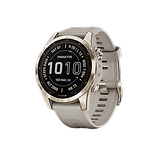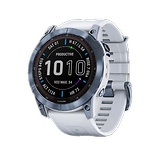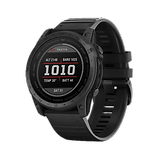
The best Garmin smartwatches in comparison
| Editor’s tip | Price tip | ||||
|---|---|---|---|---|---|
| Product | Garmin Forerunner 945 LTE | Garmin Instinct 2 | |||
| Image | 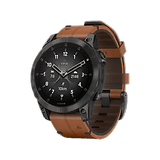 |
 |
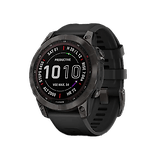 |
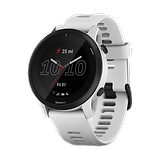 |
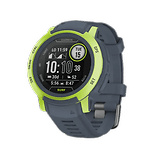 |
| Advantages |
|
|
|
||
| Disadvantages |
|
|
|
||
| Rating | Garmin Epix 2 – review | Garmin Venu 2 Plus – review | Garmin Fenix 7 – review |
|
|
| To the offer* |
In the table above you’ll find our personal highlights from Garmin’s multiple smartwatch series. In the further course of this article, we will show you all the models from the various series once again in detail, including their detailed technical specifications.
Table of contents:
1. Buying guide: What to expect from Garmin’s watches?
Garmin introduced its first sports watch with integrated GPS in 2003. Back then, the iPhone was still a distant idea in Steve Jobs’ head, and smart features in watches were dreams of the future. In 2022, we’re making phone calls and chatting on our wrists, but we’re also using our smartwatches to check our vitals and measure our fitness levels. After all, no other gadget is worn so close to the body during the day.
In the following paragraphs, we will therefore take a look at which sports and fitness features Garmin smartwatches offer on the one hand – and which smartwatch features you can expect on the other.

1.1 Sports & fitness features on Garmin watches
Clearly, the most important thing about Garmin’s watches are their sports and health features. All sports watches from Garmin – here in points 2.1 to 2.4 – offer a heart rate sensor including measurement of resting heart rate and heart rate variability. The body battery function, i.e. your daily shape, is also available on all models, as are sleep and stress tracking. And all Garmin sports watches also determine your cardio fitness in the form of the VO2Max value.
The snapshot of your health data called “Health Snap Shot” is supported by all Garmin smartwatches listed here, with the exception of the Forerunner models. The Forerunner 55 also lacks measurement for floors climbed and SpO2 values, and the Forerunner 245 does not record your respiration rate. All other models include these features.

Bluetooth, ANT+ and Wi-Fi are on board with all Garmin sports watches except the Forerunner 55. This means that the smartwatches not only connect to your Wi-Fi at home and your smartphone, but also to various accessories from Garmin, including cadence sensors for cycling or various chest straps. However, the running efficiency values that the more advanced Garmin chest straps measure are not supported by the Venu and Vivoactive series.
GPS sensors are also present everywhere. Some new models also support multi-band GPS, although we could not notice any difference to the already excellent GPS accuracy of the Garmin smartwatches in the practical test of the Epix 2, for example. By the way, all Garmin smartwatches lack an ECG measurement. If this feature is important to you, I recommend taking a look at our smartwatch best list.
1.2 Smartwatch functions in Garmin’s smartwatches
The Garmin models are not only excellent sports watches, but also smartwatches with various smart features. Notifications from smartphones are available on all models described here, as well as basic calendar functions and weather forecasts. Garmin Pay is also included in all of the watches described here (except the Forerunner 55), and Garmin’s payment service supports many banks in the USA. A current list can be found here on the Garmin website.
With the exception of the Instinct, Forerunner 55 and non-music Forerunner 245, all Garmin smartwatches offer an internal storage for music – but controlling music stored on the smartphone is possible on all watches. The Venu 2 Plus is the only model that currently supports voice assistants, and the Forerunner 945 is the only one to offer an LTE option.

All Garmin smartwatches in this comparison also have the proprietary Connect IQ Store in common. Here you can find watchfaces and data fields for workouts as well as numerous apps like Spotify, Komoot, Amazon Music or Accuweather. You can also take a look at the selection in the browser via this link.
The bottom line is that the Garmin watches offer a number of smartwatch features. However, you should not expect such a seamless integration with your smartphone as for example with the Galaxy smartwatches or the Apple Watch.
1.3 Garmin smartwatches for women and men
With very few exceptions, Garmin’s smartwatches are designated as unisex – and that’s a good thing. Fortunately, most models also come in a variety of sizes. Since women tend to have slimmer wrists, the S models should often be interesting here, for example the Garmin Fenix 7S or the Instinct 2S.
On the other hand, some models also have an X variant, for example the Garmin Fenix 7X. The 7X is particularly huge, and should also turn out too big on many men’s wrists with its ridiculously massive 51-millimeter case.
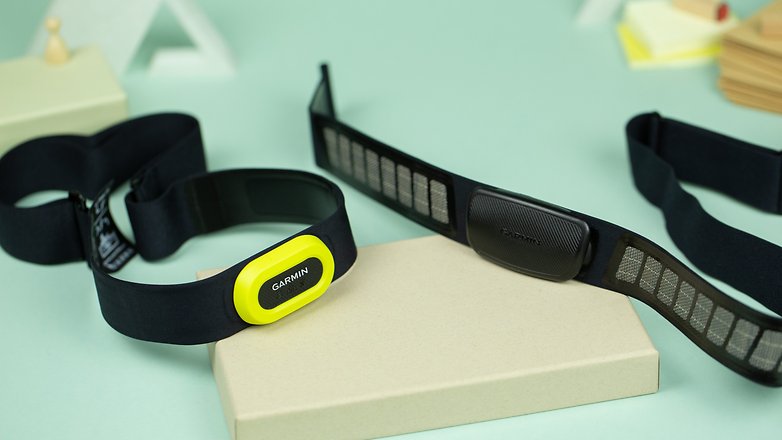
2. The best Garmin smartwatches by series
Garmin’s smartwatches can be divided very roughly into four major different series:
- For demanding users and pro athletes: Fenix, Epix, Tactix & more
- Chic all-rounders from the Vivoactive and Venu series
- Garmin’s running watches: meet the Forerunner series
- The robust models of the Instinct-2 series
2.1 For demanding users: Fenix, Epix, Tactix and more

Garmin builds the top models around the Fenix series – here, however, you have to reckon with a rather massive design and upscale prices. The Fenix 7 starts at around 600 euros, while the Tactix 7 Pro Solar Ballistic has an MSRP of 1600 euros.
For that amount of money, Garmin has squeezed just about everything that is currently possible in terms of sensors in its high-end watches – the models from the Fenix, Epix, Tactix, D2 & Co. series have all that in common. However, there are special models for different target groups that are, for example, suitable for being read with night-vision equipment or offer special safety features.
The following table shows the most important models from Garmin’s Fenix 7 series in comparison with the Epix 2, Tactix 7, Quatix 7 and D2 Mach 1.
| Product | Garmin Tactix 7 | ||||
|---|---|---|---|---|---|
| Figure |
|
|
|
|
|
| Case size | 42 mm | 47 mm | 51 mm | 47 mm | 51 mm |
| Strap size | 20 mm | 22 mm | 26 mm | 22 mm | 26 mm |
| Display technology | MIP | MIP | MIP | AMOLED | MIP |
| Display glass | Gorilla Glass or Sapphire Glass |
Gorilla Glass or Sapphire Glass |
Gorilla Glass or Sapphire Glass |
Gorilla Glass or Sapphire Glass |
Sapphire Glass |
| Display size | 1.2 inches | 1.3 inch | 1.4 inch | 1.3 inch | 1.4 inch |
| Resolution | 240 x 240 pixels | 260 x 260 pixels | 280 x 280 pixels | 416 x 416 pixels | 280 x 280 pixel |
| Touchscreen | Yes | Yes | Yes | Yes | Yes |
| Memory | 16 / 32 GB | 16 / 32 GB | 16 / 32 GB | 16 / 32 GB | 32 GB |
| Weight | 47 – 58 g | 73 – 79 g | 89 – 96 g | 70 – 76 g | 89 g |
| Battery life (smartwatch) | up to 11 d / 14 d (solar) |
up to 18 d / 22 d (solar) |
up to 28 d / 37 d (solar) |
up to 16 d | up to 28 d |
| Battery life (GPS) | up to 37 h / 46 h (solar) | up to 57 h / 73 h (solar) | up to 89 h / 122 h (solar) | up to 42 h | up to 89 h |
| Waterproof | 10 ATM | 10 ATM | 10 ATM | 10 ATM | 10 ATM |
| Special features | – | – | Flashlight | – | Tactical functions Night vision mode Flashlight |
| Solar function | depending on model | depending on model | all models | depending on model | all models |
| Variants | standard Solar Sapphire Solar |
Standard Solar Sapphire Solar |
Solar Sapphire Solar |
Standard | Standard Pro Pro Ballistics |
| Price (MSRP) | from $699 | from $699 | from $899 | from $899 | from $1099 |
| Evaluation |
|
Garmin Fenix 7 – review |
|
Garmin Epix 2 – review |
|
| To the offer* |
2.2 All-rounders from the Vivoactive and Venu series
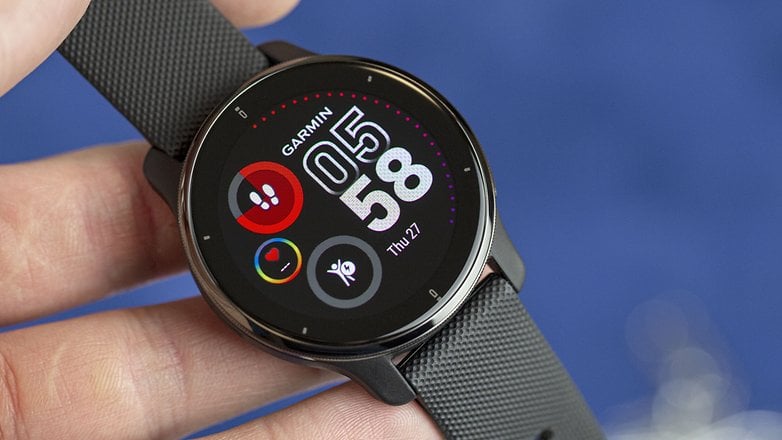
In Garmin’s Venu and Vivoactive series, you’ll find the all-rounders. These smartwatches tend to be a bit more elegantly designed than the Forerunner models, for example – and of course much more discreet than the rather bulky models from the Fenix series. While the Forerunner models are aimed more towards runners, the Venu and Vivoactive watches are rather targeted towards all-around athletes and fitness enthusiasts.
Unlike the Forerunner models, the various Venu 2 and Vivoactive 4 models offer the Health Snapshot. Here, the watch analyzes your overall health based on pulse, heart rate variability, SpO2 value, respiratory rate, and stress and gives you a summary. On the other hand, the Venu and Vivoactive models don’t have the advanced running metrics. Even with a compatible chest strap, you unfortunately won’t have access to ground contact time, vertical movement and the likes while running.
Another unique feature in Garmin’s lineup can be found in the Venu 2 Plus: The smartwatch is compatible with Siri, Bixby and Google Assistant. Thanks to the integrated microphone and speaker, you can also use the watch as a speakerphone and leave your smartphone in your pocket.
The table below shows the Garmin Venu 2S, Garmin Venu 2 Plus and Garmin Venu 2 in comparison with the Vivoactive 4S and Vivoactive 4.
| Product | Garmin Venu 2S | Garmin Venu 2 Plus | Garmin Venu 2 | Garmin Vivoactive 4S | Garmin Vivoactive 4 |
|---|---|---|---|---|---|
| Figure | 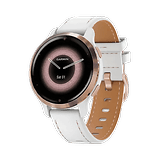 |
 |
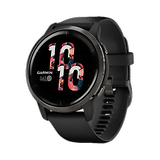 |
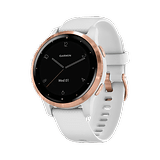 |
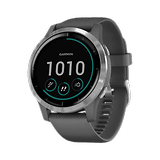 |
| Case size | 40 mm | 43 mm | 45 mm | 40 mm | 45 mm |
| Strap size | 18 mm | 20 mm | 22 mm | 18 mm | 22 mm |
| Display technology | AMOLED | AMOLED | AMOLED | MIP | MIP |
| Display glass | Gorilla Glass 3 | Gorilla Glass 3 | Gorilla Glass 3 | Gorilla Glass 3 | Gorilla Glass 3 |
| Display size | 1.1 inch | 1.3 inch | 1.3 inch | 1.1 inch | 1.3 inch |
| Resolution | 360 x 360 pixels | 416 x 416 pixels | 416 x 416 pixels | 218 x 218 pixels | 260 x 260 pixel |
| Touchscreen | Yes | Yes | Yes | Yes | Yes |
| Memory | approx. 4 GB | approx. 4 GB | approx. 4 GB | 4 GB | 4 GB |
| Weight | 38 g | 38 g | 49 g | 40 g | 51 g |
| Battery life (smartwatch) | up to 10 d | up to 9 d | up to 11 d | up to 7 d | up to 8 d |
| Battery life (GPS) | up to 7 h | up to 8 h | up to 8 h | up to 5 h | up to 6 h |
| Waterproof | 5 ATM | 5 ATM | 5 ATM | 5 ATM | 5 ATM |
| Special features | – | Supports voice assistants | – | – | – |
| Solar function | no | no | no | no | no |
| Price (MSRP) | from $351 | from $399 | from $449 | from $299 | from $299 |
| Rating |
|
Garmin Venu 2 Plus – review |
|
|
|
| To the offer* |
2.3 Garmin’s running watches: the Forerunner models
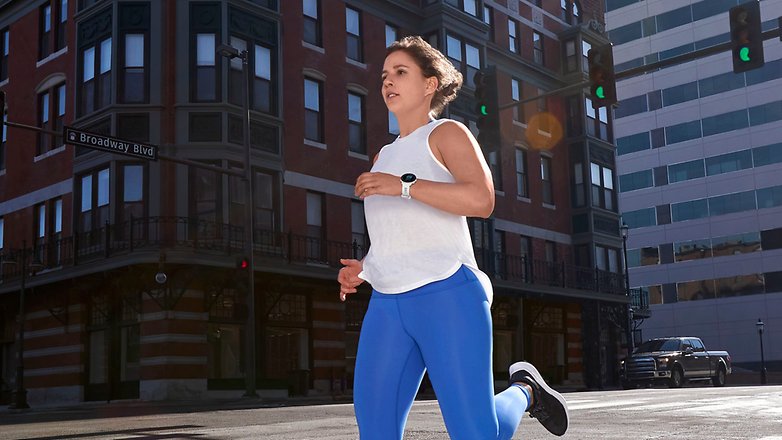
As the name suggests, Garmin’s Forerunner series is aimed at runners. Accordingly, even the second smallest model, the Forerunner 245, is equipped with running metrics so that you can get a detailed evaluation of your running efficiency values with the matching chest strap.
On the other hand, you also have to do without comfort features in the Forerunner models. For example, the entire lineup all the way to the top model does not have touchscreens, and the Health Snapshot feature is also missing. Garmin clearly differentiates between endurance athletes and all-round athletes in its two mid-range series. If you want the best of both worlds, you’ll have to reach for the Fenix models.
There are also a few features you’ll have to do without on the smaller or older Forerunner models. The Forerunner 55, for example, cannot track blood oxygen saturation and does not support running efficiency analysis. The Forerunner 245, on the other hand, lacks respiration rate measurement.
In the following table you can see the most important technical data of the Garmin Forerunner 55, Forerunner 245, Forerunner 745 and Forerunner 945 in comparison.
| Product | Garmin Forerunner 55 | Garmin Forerunner 245 | Garmin Forerunner 745 | Garmin Forerunner 945 |
|---|---|---|---|---|
| Figure | 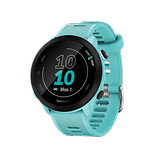 |
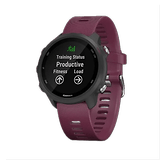 |
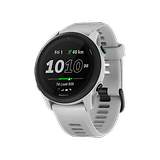 |
 |
| Case size | 42 mm | 42 mm | 44 mm | 47 mm |
| Strap size | 20 mm | 20 mm | 22 mm | 22 mm |
| Display technology | MIP | MIP | MIP | MIP |
| Display glass | Chemically reinforced glass | Gorilla Glass 3 | Gorilla Glass DX | Gorilla Glass DX |
| Display size | 1.0 inch | 1.2 inch | 1.2 inch | 1.2 inch |
| Resolution | 208 x 208 pixels | 240 x 240 pixels | 240 x 240 pixels | 240 x 240 pixels |
| Touchscreen | No | No | No | No |
| Memory | k. A. | k. A. / approx. 4 GB (music version) | approx. 4 GB | approx. 8 GB |
| Weight | 37 g | 39 g | 47 g | 49 – 50 g |
| Battery life (smartwatch) | up to 14 d | up to 7 d | up to 7 d | up to 14 d |
| Battery life (GPS) | up to 20 h | up to 24 h | up to 16 h | up to 36 h / 35 h (LTE) |
| Waterproof | 5 ATM | 5 ATM | 5 ATM | 5 ATM |
| Special features | – | – | – | LTE version available |
| Solar function | no | no | no | no |
| Variants | Standard | Standard Music |
Standard | Standard LTE |
| Price (RRP) | $169 | $249 / $299 (music) | $419 | $469 / $565 (LTE) |
| Rating |
|
|
|
|
| To the offer* |
2.4 The rugged models of the Instinct 2 series
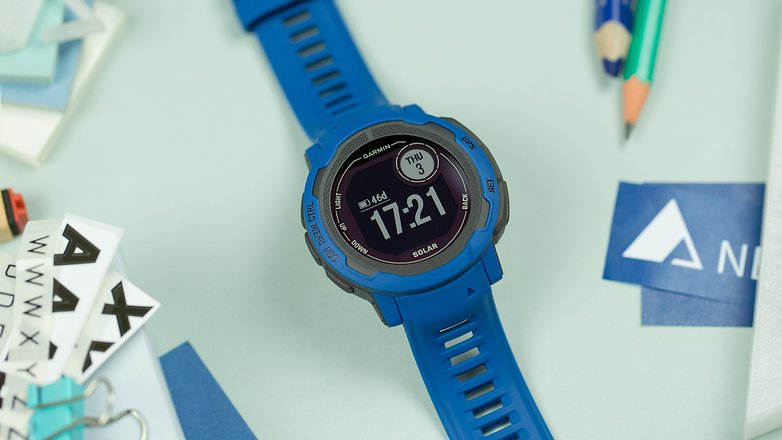
Each series below Garmin’s Fenix lineup embodies a sub-aspect of the flagship models. Garmin’s Venu and Vivoactive models are the all-rounders with broad fitness features and touchscreens, while the Forerunner models are aimed at endurance athletes. Finally, the Instinct 2 series represents the outdoor capabilities and resiliance of the Fenix lineup.
For example, the Instinct 2 and Instinct 2S offer excellent battery runtimes – and in the solar-powered variants they can even be operated permanently without recharging. That’s right: The Instinct 2 Solar offers virtually infinite battery life, as long as you get to see the sun regularly. In addition, the Instinct watches are extremely robust and water resistant up to 10 ATM.
On the other hand, you have to do without a touchscreen and instead get two nested monochrome displays with comparatively low resolution. You also have to cut back on the integrated memory. Instead, there are multiple special variants of the Instinct 2 each with their own features, for example, especially for surfers, hunters or truckers.
The following table shows the technical specifications of the Garmin Instinct 2S and Garmin Instinct 2 in comparison:
| Product | Garmin Instinct 2S | Garmin Instinct 2 |
|---|---|---|
| Figure | 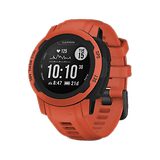 |
 |
| Case size | 40 mm | 45 mm |
| Strap size | 20 mm | 22 mm |
| Display technology | MIP (monochrome) | MIP (monochrome) |
| Display glass | Chemically reinforced glass | Power Glass |
| Display size | 0.79 x 0.79 inch | 0.9 x 0.9 inch |
| Resolution | 156 x 156 pixels | 176 x 176 pixels |
| Touchscreen | No | No |
| Memory | 32 MB | 32 MB |
| Weight | 42 – 43 g | 53 g |
| Battery life (smartwatch) | up to 21 d / 51 d (solar) | up to 28 d / unlimited (solar) |
| Battery life (GPS) | up to 22 h / 28 h (solar) | up to 30 h / 48 h (solar) |
| Waterproof | 10 ATM | 10 ATM |
| Special features | Available with special functions as Camo, Tactical, Surf and Dezl version | |
| Solar function | depending on model | depending on model |
| Variants | Standard Solar |
Standard Solar |
| Price (MSRP) | from $349 | from $349 |
| Rating |
|
|
| To the offer* | ||
More wearables from Garmin
At this point, we have focused on the four major smartwatch series from Garmin. Apart from these models, however, the manufacturer also offers a number of other wearables that we would like to mention at least once here:
- Garmin’s Vivomove series: hybrid smartwatches with an analog watch face and display.
- Garmin’s Vivosmart series: fitness trackers in the classic wristband form factor
- Garmin’s Vivofit series: simple fitness trackers with extremely long battery life
- Garmin’s Vivofit Jr models: activity trackers for kids in a robust design
- Garmin Lily: compact, fashionable smartwatch with simple fitness features
In the near future, you’ll also find more detailed information as well as reviews, how-tos and more on the above models on NextPit. Also, of course, I recommend you to check out our big smartwatch guide:
Did we forget anything, like a specific model or piece of information you’d find helpful? And which Garmin smartwatches are your favorites? We look forward to your feedback!

